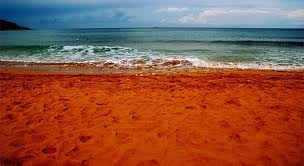NOTE: This is an earthcache, there is no physical container to find at the coordinates. To get your smiley for the cache you will need to e-mail your answers to the questions below to the cache owner. This Earthcache is located on the beach at Lori Wilson Park open after sunrise and closed at dusk.
Florida is known for its sunshine and beautiful beaches galore. Along with Florida’s vast beaches comes a surprisingly large variety of types and colors of sands.
How is sand made?
Sand is made up of silica or quartz and other hard materials: (gypsum, obsidian, coral, shells, and oolites) that have been broken down in size between .06-2.0 mm by mechanical and chemical weathering. First the rocks are broken down by mechanical weathering through conditions such as heat, water, ice, and pressure. After the rocks are mechanically weathered they are then broken down further by chemical weathering. Chemical weathering takes place through chemical interactions with naturally acidic rainfall and water or from chemicals released by organisms.
Sea animals also help with the breaking down of rocks into sand. The Parrot fish for example eat coral reefs with their sharp teeth and then excrete sand. An adult Parrot fish produces up to 1 ton of finely ground sand per acre of reef each year!

After reaching a certain size the broken down rock particles can easily move and are tossed around by the wind and water. As the particles rub against each other they break down even further in size. Eventually the particles are carried by the wind and form dunes or are carried by water to lakes or seas where they form into beaches.
What makes sand different colors?
The color of sand in a particular beach often reflects the surrounding landscape and the composition of the nearby ocean floor. Color changes depending on what the quartz crystals are combined with. Shell fragments and coral, limestone, lava, fossils and organic matter, all lead different colors of sand.
Black- Black sand is made from ground lava or black or dark brown fossil fragments mixed with white quartz sand. Due to surrounding volcanoes, Hawaii is famous for its black sand beaches.

Orange- Orange sand on sight appears that the sand is orange but the color actually comes from the coquina shell fragments that have absorbed the rusty color of iron oxide. Orange sand beaches can be found it the Mediterranean as well as Florida and Hawaii.

Pink- Pink sand occurs in areas near large coral reef formations which contain a microscopic shelled animal known as Foraminifera. When the Foraminifera die their skeletons fall to the ocean floor, erode, and then carried to the shore. Pink sand beaches can be found in the Bahamas, Puerto Rico, and the Philippines.

Brown/Tan/White- Brown/Tan/White sand is made from tiny fragments of shell and corals mixed with quartz sand. The East coast of the United States has some of the whiter beaches. The state of Florida specifically is well known for its famous white sand beaches.

How do seasons effect beaches?
The amount of sand on the beach changes depending on the season. There are two main types of beach seasons:
1-Winter Beach- During the winter months the ocean creates large swells which are made by storms and cold fronts. As these swells reach the shores they break down the beach and wash the sand into the water.
2-Summer Beach- During the summer months the weather is warmer and the elements are generally not as violent. The ocean swells are not as large in the summer and slowly the sand gets re-deposited back on to the beach.

References:
https://en.wikipedia.org/wiki/Sand
http://www.plumislandresearch.org/media-library/sights-and-sounds-of-science/first-noreaster-2014-15-season
http://www.visitflorida.com/articles/battle-of-the-beach-sands
CONGRATULATIONS TO ROBEAGL & WAPITIWOMAN FTF!!!
Questions:
1-What is the color and composition of sand you see on the surface of the beach?
2-Dig down into the sand until you reach the next layer of color. (Be prepared, some seasons may require deeper digging than others). What is the color and composition of this layer of sand?
3-How many inches did you dig down until you saw the next color?
4-What do you think is responsible for the color change?
5-During your visit would you say the beach is a winter beach or summer beach and why?
Thank you for visiting this earthcache. Please send your answers to the above questions to the cache owner. In your "found it" log feel free to write about your experience, but don't include the earthcache answers. Thanks and we hope you enjoy beautiful Cocoa Beach!
